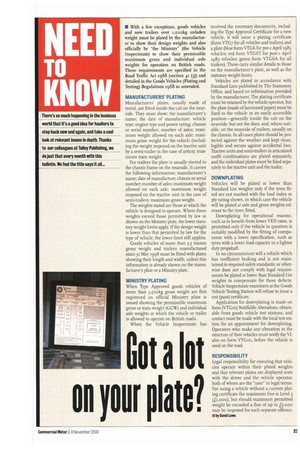• With a few exceptions, goods vehicles and new trailers
Page 25

If you've noticed an error in this article please click here to report it so we can fix it.
over Lozokg unladen weight must be plated by the manufacturer to show their design weights and also officially by the Ministry (the Vehicle Inspectorate) to show their permissible maximum gross and individual axle weights for operation on British roads. These requirements are specified in the Road Traffic Act 1988 (section 41 (3)) and detailed in the Goods Vehicles (Plating and Testing) Regulations 1988 as amended.
MANUFACTURERS' PLATING Manufacturers' plates, usually made of metal, are fitted inside the cab on the nearside. They must show: the manufacturer's name; the date of manufacture; vehicle type; engine type and power rating; chassis or serial number; number of axles; maximum weight allowed on each axle; maximum gross weight for the vehicle (including the weight imposed on the tractive unit by a semi-trailer in the case of artics); maximum train weight.
For trailers the plate is usually riveted to the chassis frame on the nearside. It carries the following information: manufacturer's name; date of manufacture; chassis or serial number; number of axles; maximum weight allowed on each axle; maximum weight imposed on the tractive unit in the case of semi-trailers; maximum gross weight.
The weights stated are those at which the vehicle is designed to operate. Where these weights exceed those permitted by law as shown on the Ministry plate, the lower statutory weight limits apply. If the design weight is lower than that permitted by law for the type of vehicle, the lower limit still applies.
Goods vehicles of more than 3.5 tonnes gross weight and trailers manufactured since 31 May 1998 must be fitted with plates showing their length and width, unless this information is already shown on the manufacturer's plate or a Ministry plate.
MINISTRY PLATING When Type Approved goods vehicles of more than 3,500kg gross weight are first registered an official Ministry plate is issued showing the permissible maximum gross or train weight (GCW) and individual axle weights at which the vehicle or trailer is allowed to operate on British roads.
When the Vehicle Inspectorate has received the necessary documents, including the Type Approval Certificate for a new vehicle, it will issue a plating certificate (form VTG7 for all vehicles and trailers) and a plate (blue form VTG6 for pre-1 April 1983 vehicles; red form VTG6T for post-I April 1983 vehicles; green form VTG6A for all trailers). These carry similar details to those on the manufacturer's plate, as well as the statutory weight limits.
Vehicles are plated in accordance with Standard Lists published by The Stationery Office, and based on information provided by the manufacturer. The plating certificate must be retained by the vehicle operator, but the plate (made of laminated paper) must be fixed to the vehicle in an easily accessible position—generally inside the cab on the nearside, but not the door, and, where suitable, on the nearside of trailers, usually on the chassis. In all cases plates should be protected against the weather and kept dean, legible and secure against accidental loss. Tractive units and semi-trailers in articulated outfit combinations are plated separately, and the individual plates must be fixed separately to the tractive unit and the trailer.
DOWN PLATING Vehicles will be plated at lower than Standard List weights only if the tyres fitted are not marked with the load index or ply rating shown, in which case the vehicle will be plated at axle and gross weights relevant to the tyres fitted.
Downplating for operational reasons, such as to benefit from lower VED rates, is permitted only if the vehicle in question is suitably modified by the fitting of components with a lower specification, such as tyres with a lower load capacity or a lighter duty propshafi.
In no circumstances will a vehicle which has inefficient braking and is not maintained to required safety standards; or otherwise does not comply with legal requirements be plated at lower than Standard List weights to compensate for these defects. Vehicle Inspectorate examiners at the Goods Vehicle Testing Station will refuse to issue a test (pass) certificate.
Application for downplating is made on form (VTGro) Notifiable Alterations, obtainable from goods vehicle test stations, and contact must be made with the local test station for an appointment for downplating. Operators who make any alteration to the structure of their vehicles must notify the VI, also on form VTGio, before the vehicle is used on the road.
Legal responsibility for ensuring that vehicles operate within their plated weights and that relevant plates are displayed rests
on your plate. both of whom are the "user" in legal terms. weight be exceeded a fine of up to £5,000 may be imposed for each separate offence. E by David Lowe
plating certificate the maximum fine is Level 3
(11,000), but should maximum permitted For using a vehicle without a current with the driver and the vehicle operator,












































































































